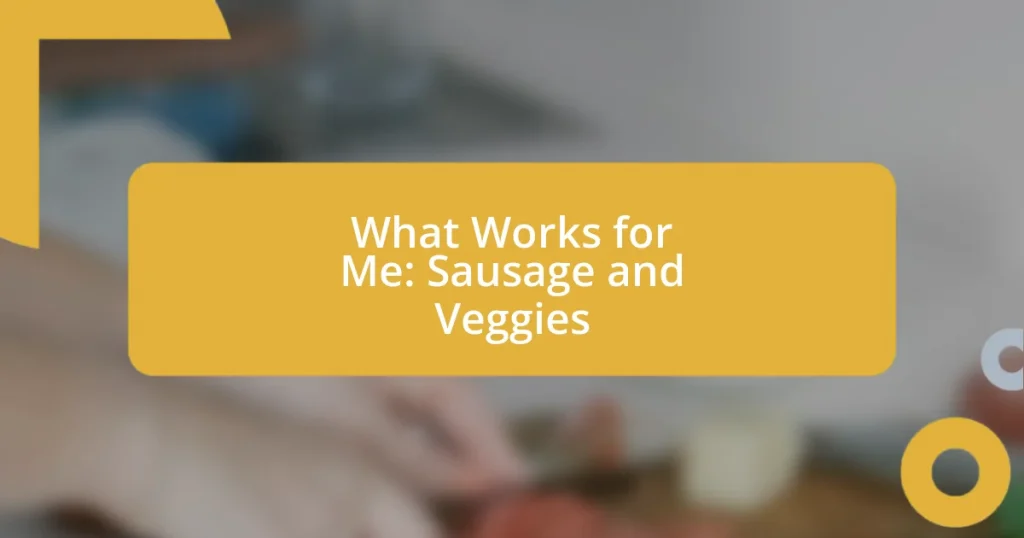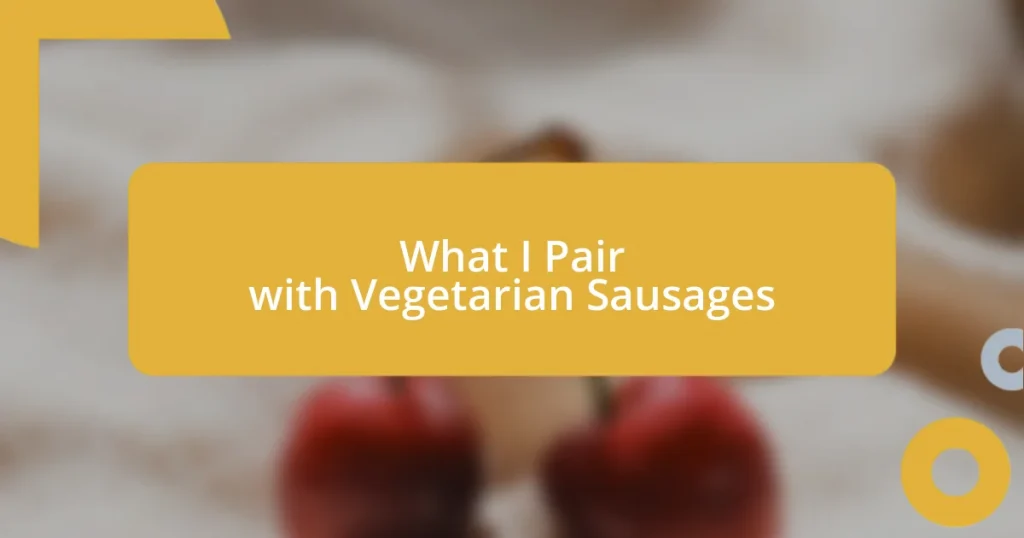Key takeaways:
- Sausage-free days encourage exploration of new flavors and ingredients, enhancing culinary creativity and a deeper connection to nutrition.
- Eliminating sausage leads to increased energy levels, mindful eating, and a greater appreciation for food origins and choices.
- Planning meals and using healthy alternatives help overcome challenges, while incorporating variety and seasonal produce enhances the overall dining experience.
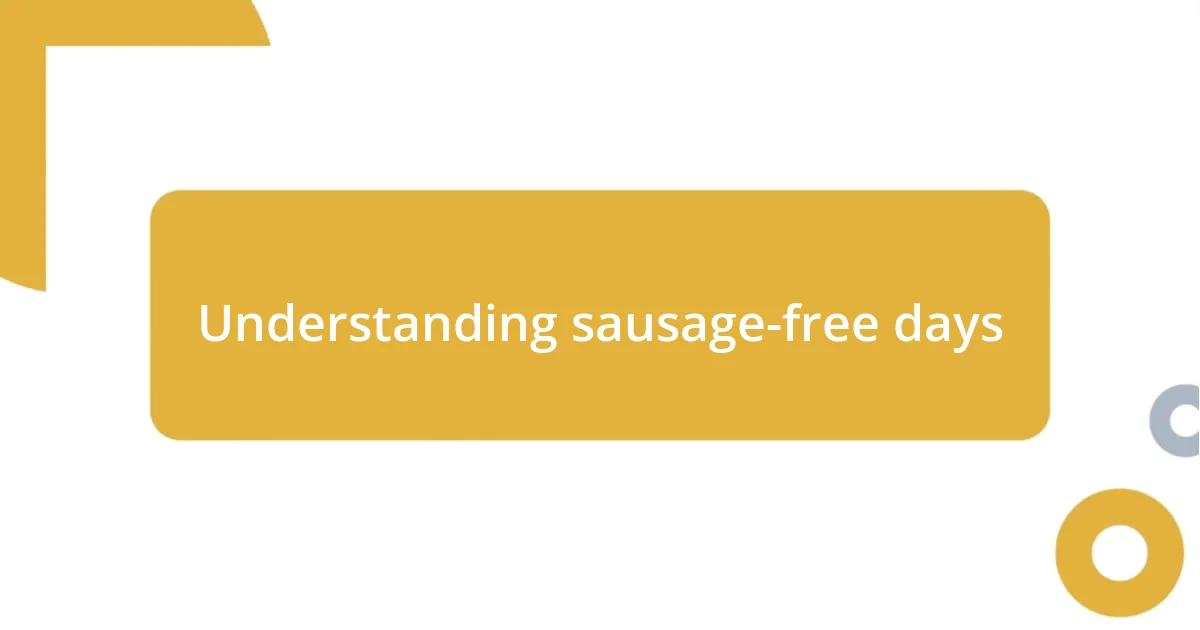
Understanding sausage-free days
Sausage-free days can serve as an enlightening experience, offering a break from the usual dietary habits. I remember the first time I consciously decided to skip sausage for a week; it felt both liberating and slightly intimidating. How would I replace those comforting, savory flavors in my meals?
The beauty of sausage-free days lies in the exploration of new flavors and ingredients. I discovered vibrant plant-based alternatives that not only nourished my body but also surprised my taste buds. It made me wonder, have you ever ventured into a culinary world you didn’t know existed?
Engaging in sausage-free days can also enhance our relationship with food. There’s something refreshing about reconnecting with whole ingredients, swapping out the usual for fresh vegetables, legumes, and grains. Reflecting on my journey, I realized that it’s not just about eliminating sausage—it’s about embracing a broader perspective on nutrition and health.
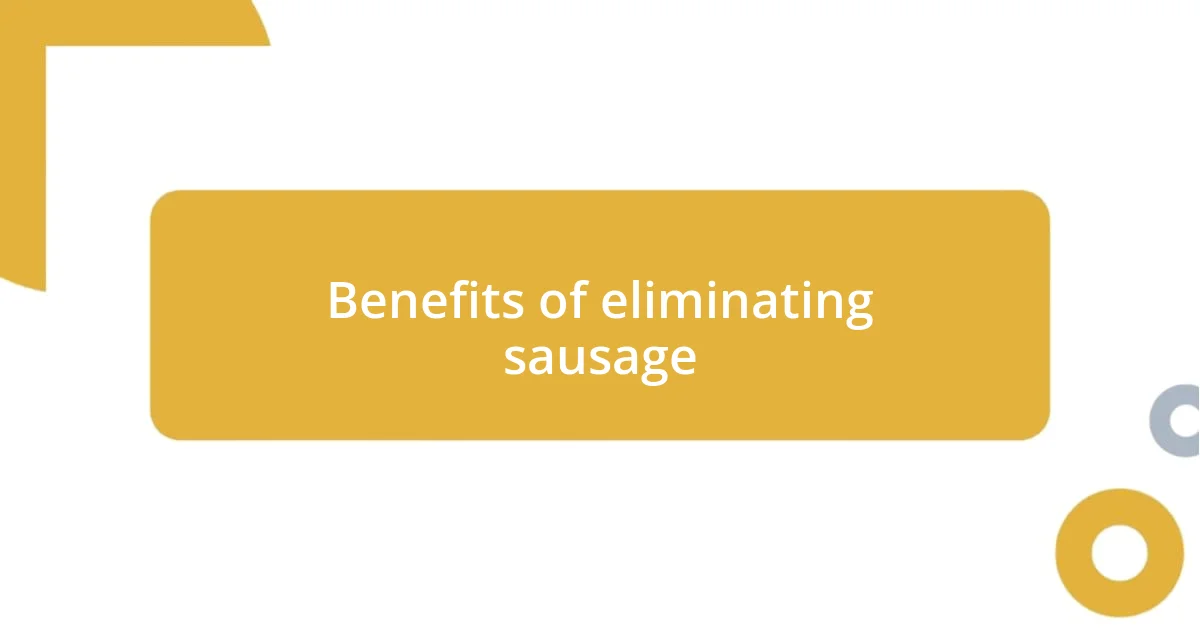
Benefits of eliminating sausage
There are numerous benefits to eliminating sausage from your diet that go beyond health considerations. One immediate change I’ve noticed is an increase in energy levels. Without the heaviness associated with processed meats, I felt lighter and more vibrant. It was surprising to experience how small dietary tweaks could lead to such noticeable changes.
I also love the newfound creativity in my cooking. Reducing sausage opened the door to experimenting with various spices and flavors. I found myself creating dishes infused with diverse ingredients—like experimenting with lentils, herbs, and ethnic cuisines. This journey into uncharted culinary territory made meals not just nourishing but exciting. Isn’t it fascinating how stepping away from the familiar can lead to delicious discoveries?
Moreover, there’s a profound emotional aspect to this experience. Following sausage-free days, I became more mindful of my food choices. Each meal felt intentional, allowing me to foster a deeper connection to what I consumed. I’ve come to appreciate the origins of my food and the impact of my choices on my body and the environment. Doesn’t that inspire a sense of responsibility toward our dietary habits?
| Benefits of Eliminating Sausage | Description |
|---|---|
| Increased Energy | Removing sausage can result in feeling lighter and more vibrant, as processed meats can often lead to sluggishness. |
| Culinary Creativity | Eliminating sausage encourages exploration of new flavors and cooking techniques, leading to more exciting and varied meals. |
| Mindful Eating | Engaging in sausage-free days enhances awareness of food choices, fostering a deeper connection to what we consume. |
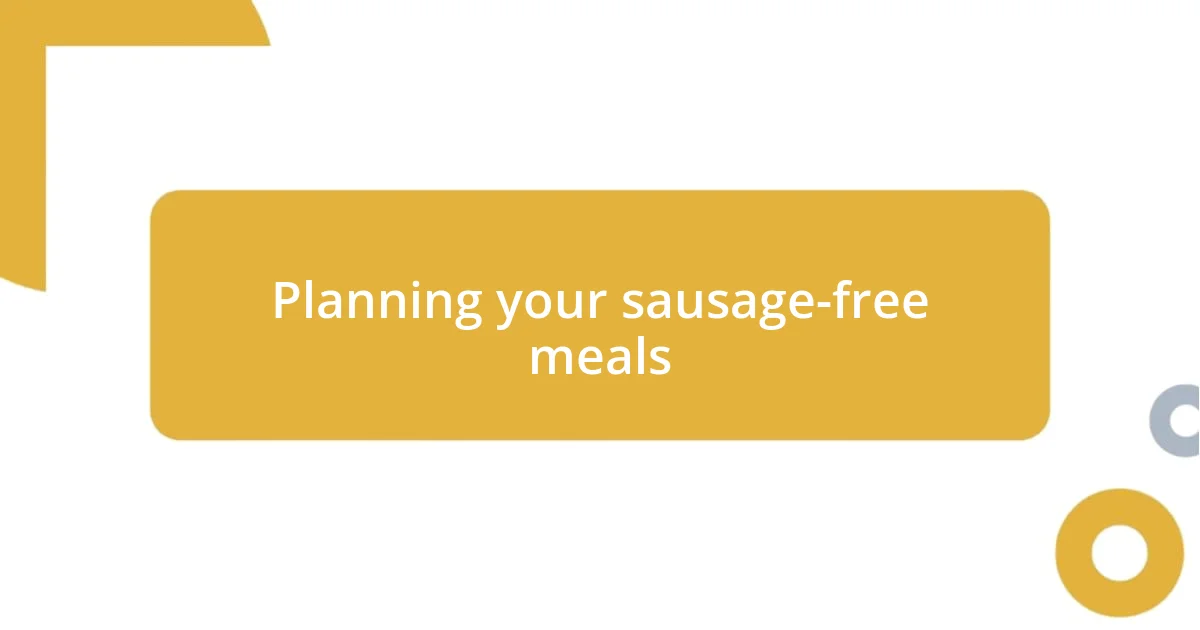
Planning your sausage-free meals
Planning your meals for sausage-free days can be an exciting challenge. I often set aside some time at the beginning of the week to think through my meals, exploring how I can make them hearty and satisfying without sausage. It’s become a sort of culinary adventure for me—discovering what flavors and textures can fill that savory void.
- Make a list of your favorite vegetables and proteins. Consider options like mushrooms, chickpeas, or tempeh for a satisfying bite.
- Experiment with spices and herbs that add depth to your dishes; flavors like smoked paprika or fresh basil can make a significant difference.
- Try creating one-pot dishes, such as hearty stews or grain bowls, that allow different ingredients to shine together.
- Look online for recipes that focus on plant-based meals for inspiration. I’ve found that browsing food blogs often leads to unexpected flavor pairings.
- Keep your pantry stocked with versatile staples like quinoa, beans, or seasonal vegetables so you’re always ready to whip up something delicious.
Taking time to plan not only eases the cooking process but also creates a sense of anticipation for the meals to come. When I successfully make these dishes and enjoy them, I feel a great sense of accomplishment—proof that I can thrive without relying on my old favorites.
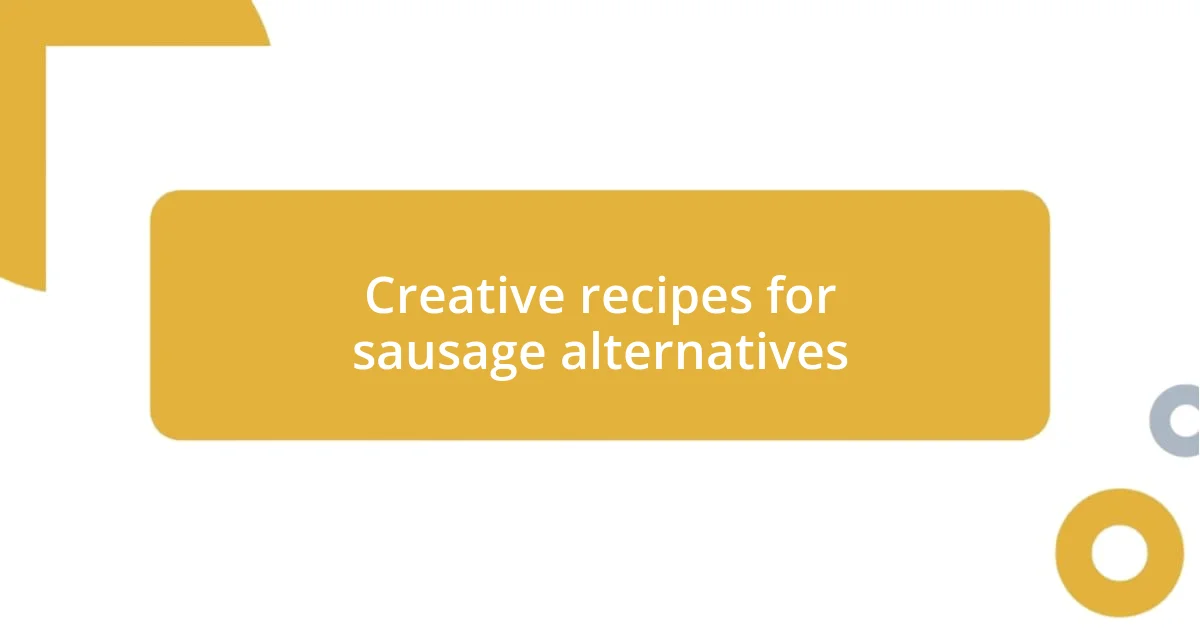
Creative recipes for sausage alternatives
One of my absolute favorite alternatives to sausage is a spiced chickpea and sweet potato hash. I simply sauté diced sweet potatoes until they’re tender, then add canned chickpeas, smoked paprika, and a pinch of cumin. The combination creates a hearty, filling dish that’s bursting with flavor and texture. Doesn’t it feel satisfying to know you’re getting protein and fiber in each bite while enjoying the warmth of spices?
Another standout recipe for me has been stuffed bell peppers with quinoa and black beans. I season the mixture with cilantro, lime juice, and a dash of chili powder for that kick. When I pull them out of the oven, the aroma fills my kitchen and wraps me in a cozy embrace. Isn’t it amazing how a colorful dish can uplift your mood? Plus, they keep well, so I often enjoy the leftovers the next day for lunch; it feels great to have nutritious meals ready to go!
Finally, I can’t resist a good grilled vegetable skewers dish. I usually include zucchini, bell peppers, and red onions, marinated in balsamic vinegar and garlic. The char from the grill adds a delightful smokiness that almost feels like it could rival my old sausage favorites. When I bite into them, I can’t help but smile—who knew that cutting back on sausage could bring such delicious surprises into my meal rotation? Wouldn’t it be wonderful to rediscover our connection to food through these fresh, vibrant ingredients?
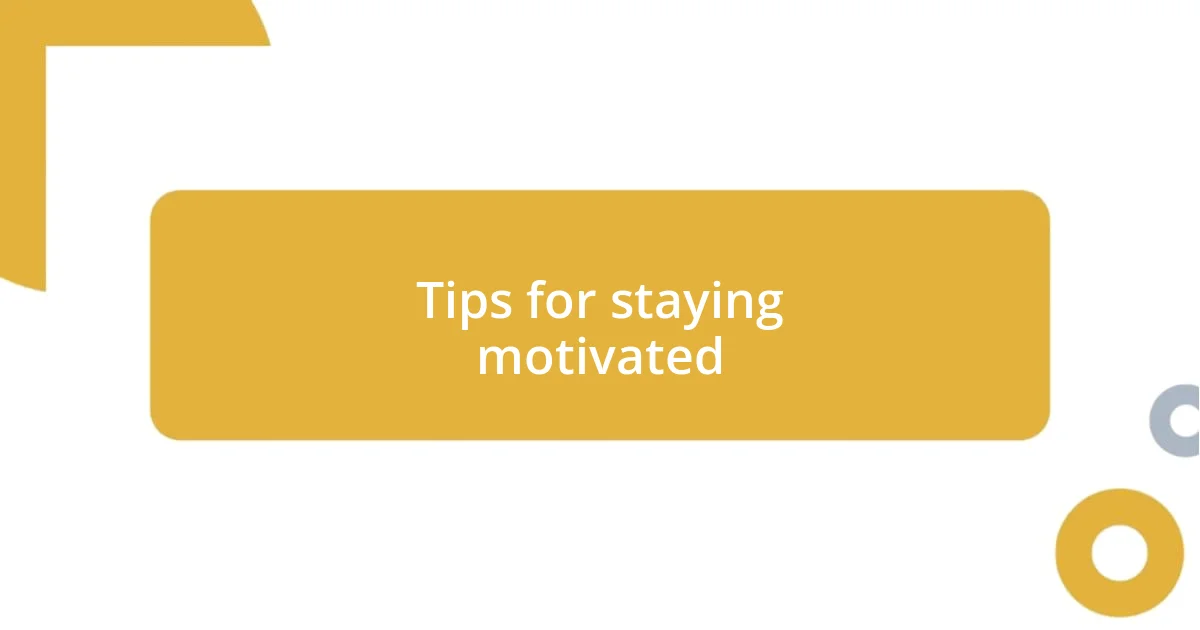
Tips for staying motivated
Staying motivated on sausage-free days often comes down to finding joy in the process. For me, setting small, achievable goals works wonders—like perfecting a new recipe or trying out a unique ingredient. I still remember the thrill of creating a creamy cashew sauce that I never thought I could whip up, and now it’s a staple in my meals. Remember that small victories can lead to greater motivation; celebrating them keeps the journey exciting.
Another key aspect is to create a supportive environment. I like to share my sausage-free meals with friends and family, inviting them to taste my latest culinary inventions. There’s something incredibly rewarding about their reactions when they enjoy a dish I’ve crafted without sausage. It not only boosts my confidence but also strengthens my resolve. Have you thought about how communal dining can inspire you to stick to your goals?
Lastly, I find it essential to keep a food journal or photo log of my meals. Documenting my creations instantly makes me more aware of what I’m eating and provides a tangible reminder of my progress. Sometimes, I flip through those pages and feel a rush of pride seeing how far I’ve come. It’s a great motivator to hit the kitchen again. Does this resonate with you? It might just be the push you need to keep exploring flavors and enjoyable meals!
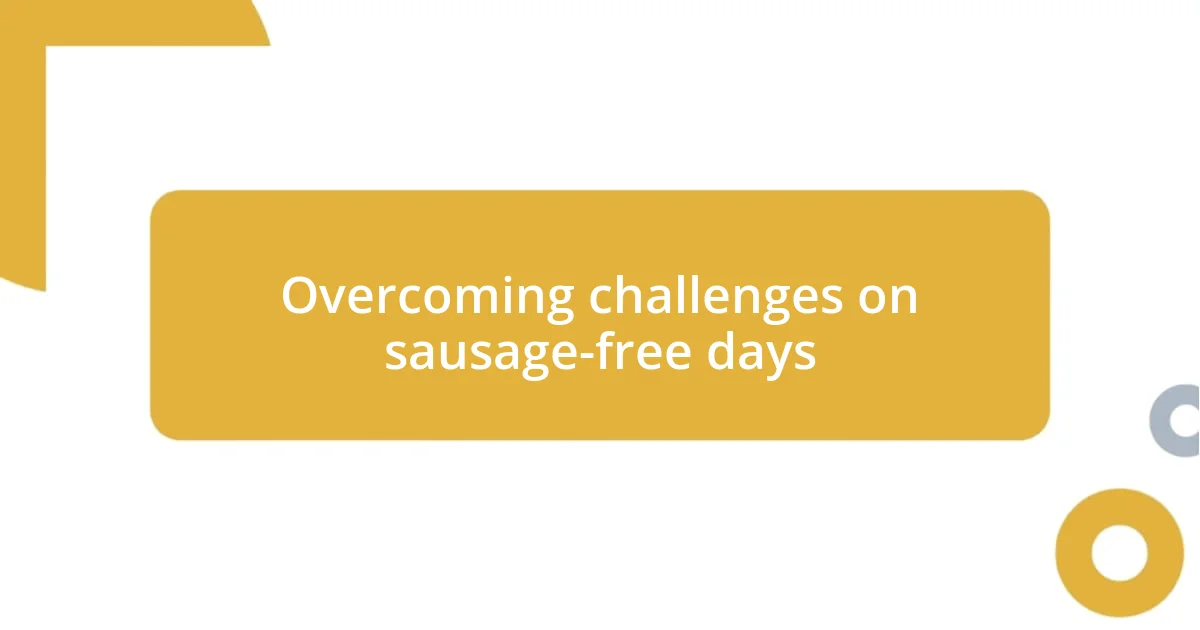
Overcoming challenges on sausage-free days
Overcoming the urge to reach for sausage on those challenging days truly tests my commitment. I recall a particular weekend when I was at a BBQ, and everyone around me was enjoying their sausages. Instead of giving in, I decided to bring along my own zesty bean burgers. To my surprise, several friends wanted to try them! It’s moments like these that reinforce my belief; staying strong can open doors to unexpected social connections.
Sometimes, cravings strike at odd hours, making it tempting to abandon my sausage-free commitment. I’ve learned to keep healthy snacks on hand—like crunchy roasted chickpeas or homemade veggie sticks with hummus. Whenever those nighttime urges hit, I simply reach for a tasty alternative. Have you ever noticed how having a plan can change your approach? It’s like putting on an armor against temptation!
I also find that preparing meals in advance turns a potentially tricky day into a seamless experience. I remember one Sunday, batch-cooking several sausage-free dishes created a sense of peace for the week ahead. When I’ve got flavorful soups or stews ready to go, I don’t feel the pull toward less healthy options. Isn’t it great how a little prep can pave the way for success?
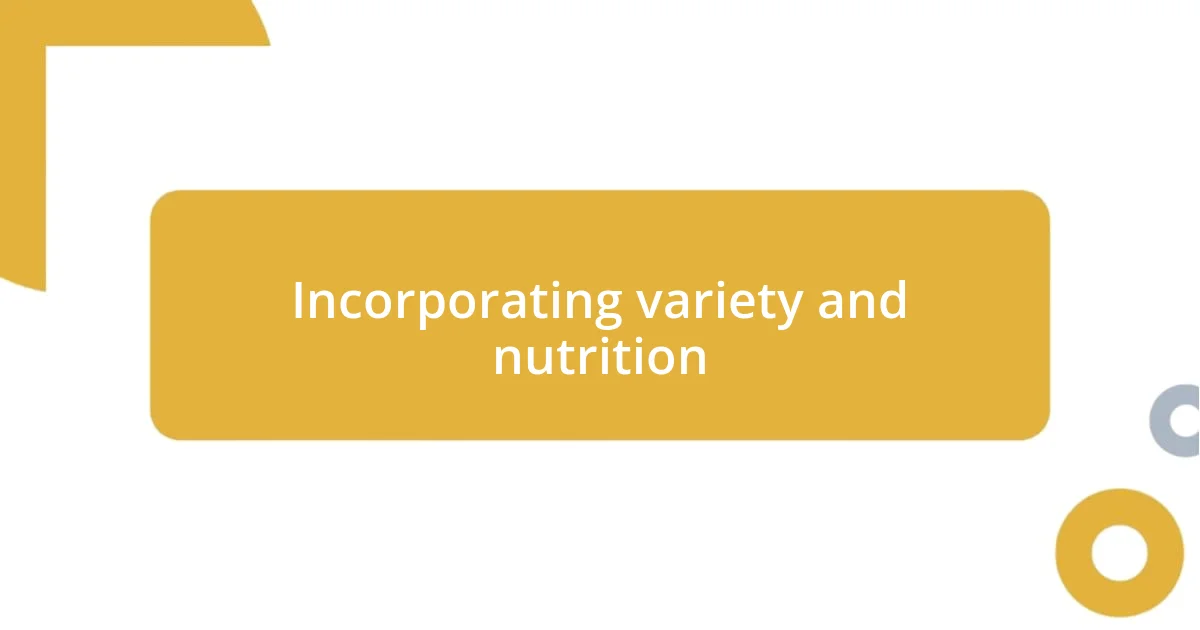
Incorporating variety and nutrition
Incorporating variety and nutrition into my meals has transformed my sausage-free experience into an exciting culinary adventure. I still vividly remember the first time I introduced quinoa into my diet; the fluffy texture and nutty flavor added unexpected depth to my salads. It’s a game-changer to blend different grains, legumes, and vegetables, not just for nutrition, but also to keep my taste buds engaged. Have you ever considered how much variety can elevate your meals?
One of my go-to strategies is to experiment with global flavors. When I’m feeling a bit bland in my cooking, I dive into the spices from various cuisines. A particular favorite is Moroccan-inspired chickpea stew, packed with warming spices like cumin and coriander. The vibrant colors and aromatic scents remind me that food can be an experience rather than just sustenance. How do you spice things up in your kitchen?
I also focus on seasonal produce, which not only supports my nutritional goals but enhances the freshness and flavor of my dishes. Last fall, I embraced the bounty of roasted root vegetables, turning them into colorful medleys sprinkled with herbs. There’s something incredibly rewarding about eating with the seasons—it connects me to the rhythms of nature and makes every meal feel like a celebration. Have you noticed how much more satisfying fresh ingredients can be?













